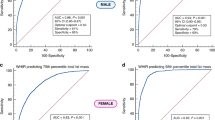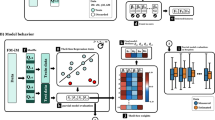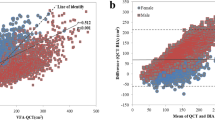Abstract
Objective:
To test the hypothesis that variations in trunk circumferences influence the accuracy of bioimpedance analysis (BIA) for assessment of percent fat mass (%FM).
Subjects and Methods:
%FM was predicted with BIA, and compared with air-displacement plethysmography (ADP) in a small sample of 35 overweight (OW), 21 normal weight and 8 underweight volunteers. Waist and hip circumferences were assessed, and 15 of the OW subjects were measured before and after weight reduction.
Results:
BIA and ADP provided similar cross-sectional estimates of group mean %FM (28.9±10.0 and 31.3±13.0%, respectively). However, within individuals, there were large between-method differences (DiffBIA−ADP) ranging from −13 to +13 %FM. Furthermore, we found a systematic bias of BIA related to the degree of adiposity. Consequently, %FM and fat mass loss during weight reduction in OW were underestimated with BIA when compared with ADP. Waist and hip circumferences were inversely associated with resistance (R) and reactance (P<0.01), and with DiffBIA−ADP (P<0.001). In women, the variability in hip circumference explained 76%, and in men, the variability in waist circumference explained 59% of DiffBIA−ADP.
Conclusion:
Resistance changes associated with variations in trunk circumferences decrease resistance, and therefore impair the accuracy of BIA to assess %FM.
This is a preview of subscription content, access via your institution
Access options
Subscribe to this journal
Receive 12 print issues and online access
$259.00 per year
only $21.58 per issue
Buy this article
- Purchase on Springer Link
- Instant access to full article PDF
Prices may be subject to local taxes which are calculated during checkout


Similar content being viewed by others
References
Bland JM (1986). Statistical methods for assessing agreement between two methods of clinical measurement. The Lancet 8, 307–310. Ref Type: Generic.
Bosy-Westphal A, Later W, Hitze B, Sato T, Kossel E, Gluer CC et al. (2008). Accuracy of bioelectrical impedance consumer devices for measurement of body composition in comparison to whole body magnetic resonance imaging and dual X-ray absorptiometry. Obes Facts 1, 319–324.
Deurenberg P (1996). Limitations of the bioelectrical impedance method for the assessment of body fat in severe obesity. Am J Clin Nutr 64, 449S–452S.
Fogelholm GM, Sievanen HT, van Marken Lichtenbelt WD, Westerterp KR (1997). Assessment of fat-mass loss during weight reduction in obese women. Metabolism 46, 968–975.
Haroun D, Wells JC, Williams JE, Fuller NJ, Fewtrell MS, Lawson MS (2005). Composition of the fat-free mass in obese and nonobese children: matched case-control analyses. Int J Obes (Lond) 29, 29–36.
Hoffer EC, Meador CK, Simpson DC (1969). Correlation of whole-body impedance with total body water volume. J Appl Physiol 27, 531–534.
Kyle UG, Bosaeus I, De Lorenzo AD, Deurenberg P, Elia M, Manuel GJ et al. (2004a). Bioelectrical impedance analysis-part II: utilization in clinical practice. Clin Nutr 23, 430–1453.
Kyle UG, Bosaeus I, De Lorenzo AD, Deurenberg P, Elia M, Gomez JM et al. (2004b). Bioelectrical impedance analysis--part I: review of principles and methods. Clin Nutr 23, 1226–1243.
Lukaski HC, Johnson PE, Bolonchuk WW, Lykken GI (1985). Assessment of fat-free mass using bioelectrical impedance measurements of the human body. Am J Clin Nutr 41, 810–817.
Neovius M, Hemmingsson E, Freyschuss B, Udden J (2006). Bioelectrical impedance underestimates total and truncal fatness in abdominally obese women. Obesity (Silver Spring) 14, 1731–1738.
Sun SS, Chumlea WC, Heymsfield SB, Lukaski HC, Schoeller D, Friedl K et al. (2003). Development of bioelectrical impedance analysis prediction equations for body composition with the use of a multicomponent model for use in epidemiologic surveys. Am J Clin Nutr 77, 331–340.
Waki M, Kral JG, Mazariegos M, Wang J, Pierson Jr RN, Heymsfield SB (1991). Relative expansion of extracellular fluid in obese vs. nonobese women. Am J Physiol 261, E199–E203.
Webber J, Donaldson M, Allison SP, Macdonald IA (1994). A comparison of skinfold thickness, body mass index, bioelectrical impedance analysis and dual-energy X-ray absorptiometry in assessing body composition in obese subjects before and after weight loss. Clin Nutr 13, 177–182.
Zhu F, Schneditz D, Wang E, Levin NW (1998). Dynamics of segmental extracellular volumes during changes in body position by bioimpedance analysis. J Appl Physiol 85, 497–504.
Acknowledgements
We thank Anke Strauss and Gritt Stoffels for their support during the weight reduction program. The German Obesity Network of Competence (Collaborative Project ADIPOSETARGET, 01GI0830) supported the study, which was a joint project between Charité University Medicine (Berlin, Germany), Metanomics GmbH (Berlin, Germany) and Hannover Medical School. The Federal Ministry of Education and research (BMBF-0313868) also supported this work, as did the Commission of the European Communities (Collaborative Project ADAPT, Contract No. HEALTH-F2-2008-201100).
Author information
Authors and Affiliations
Corresponding author
Ethics declarations
Competing interests
The authors declare no conflict of interest.
Rights and permissions
About this article
Cite this article
Haas, V., Engeli, S., Hofmann, T. et al. Variations in truncal body circumferences affect fat mass quantification with bioimpedance analysis. Eur J Clin Nutr 66, 196–200 (2012). https://doi.org/10.1038/ejcn.2011.154
Received:
Revised:
Accepted:
Published:
Issue Date:
DOI: https://doi.org/10.1038/ejcn.2011.154
Keywords
This article is cited by
-
Comparing single-frequency bioelectrical impedance analysis against deuterium dilution to assess total body water
European Journal of Clinical Nutrition (2012)



